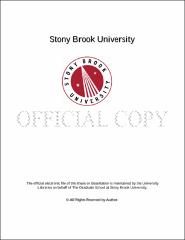| dc.identifier.uri | http://hdl.handle.net/11401/77565 | |
| dc.description.sponsorship | This work is sponsored by the Stony Brook University Graduate School in compliance with the requirements for completion of degree. | en_US |
| dc.format | Monograph | |
| dc.format.medium | Electronic Resource | en_US |
| dc.language.iso | en_US | |
| dc.publisher | The Graduate School, Stony Brook University: Stony Brook, NY. | |
| dc.type | Dissertation | |
| dcterms.abstract | In many medical imaging systems used in radiology, the hardware delivers raw data to a sensor and a computer is used to convert the sensor data to a viewable image by implementing tomographic reconstruction algorithms. The radiologist views the image and performs a task, such as detecting a lesion. Engineers and applied mathematicians seek to improve medical imaging systems by making hardware changes and changes in the reconstruction algorithm. Improvement in this thesis is measured by scalar figures of merit, FOM, for task performance. We consider two modalities: SPECT (Single Photon Emission Computed Tomography) and Contrast-Enhanced DBT (Digital Breast Tomosynthesis). For SPECT, the tasks are detection of a signal and detection plus localization of a signal. We seek to improve the collimator (hardware) and regularizer of the reconstruction algorithm to improve SPECT task performance. We use the tools of statistical decision theory. The FOMs are area under the ROC curve for detection and area under the LROC curve for detection plus localization. We find that lower resolution collimators improve performance when coupled with an appropriate regularizer. For Contrast-Enhanced DBT, we alter the sequence of acquisitions by the X-ray tube by interleaving high and low energy acquisitions, and we alter the standard Filtered Backprojection (FBP) algorithm and use OS-SART (Ordered Subset Simultaneous Algebraic Reconstruction Technique). This improves SDNR (Signal-Difference-to-Noise-Ratio), a FOM that is correlated with lesion detection performance. Key to the SPECT work is the use of mathematical observers, essentially feature extraction plus decision algorithms, that effectively emulate human performance in the detection and detection-localization tasks. Without these, the amount of labor involved in human observer studies is unrealistic. | |
| dcterms.available | 2017-09-20T16:52:55Z | |
| dcterms.contributor | Jiao, Xiangmin | en_US |
| dcterms.contributor | Gindi, Gene | en_US |
| dcterms.contributor | Wu, Song | en_US |
| dcterms.contributor | Zhu, Wei | en_US |
| dcterms.contributor | Liang, Jerome. | en_US |
| dcterms.creator | Chen, Lin | |
| dcterms.dateAccepted | 2017-09-20T16:52:55Z | |
| dcterms.dateSubmitted | 2017-09-20T16:52:55Z | |
| dcterms.description | Department of Applied Mathematics and Statistics. | en_US |
| dcterms.extent | 150 pg. | en_US |
| dcterms.format | Monograph | |
| dcterms.format | Application/PDF | en_US |
| dcterms.identifier | http://hdl.handle.net/11401/77565 | |
| dcterms.issued | 2015-12-01 | |
| dcterms.language | en_US | |
| dcterms.provenance | Made available in DSpace on 2017-09-20T16:52:55Z (GMT). No. of bitstreams: 1
Chen_grad.sunysb_0771E_12224.pdf: 4544868 bytes, checksum: d199009394aedccf9ab840ff76eadba8 (MD5)
Previous issue date: 1 | en |
| dcterms.publisher | The Graduate School, Stony Brook University: Stony Brook, NY. | |
| dcterms.subject | Medical imaging and radiology | |
| dcterms.subject | CHO Observer, Image Reconstruction, Joint Optimization | |
| dcterms.title | Statistical Methods for Optimizing Task Performance in Nuclear Medicine Imaging and in X-ray Breast Imaging | |
| dcterms.type | Dissertation | |

